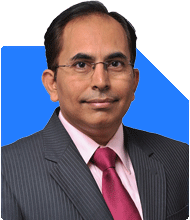How can I retire with a Rs.1 lakh monthly pension at 50?
Ramalingam Kalirajan |10890 Answers |Ask -Follow
Mutual Funds, Financial Planning Expert - Answered on Jul 29, 2024
He has an MBA in finance from the University of Madras and is a certified financial planner.
He is the director and chief financial planner at Holistic Investment, a Chennai-based firm that offers financial planning and wealth management advice.... more

Respected Sir, I am 40 years female with husband and 8years old daughter. My monthly salary is around 60k with 5%yearly increment.current investment portfolio is around 14 lacs in stock market. 1lac in SGB.ppf balance is around 10.38 lacs. I have one SSA account balance 13.6 lacs. I have endowment plans of current surrender value of around 4 lacs. I can invest 40 k currently through sip. Is it possible for me to retire at the age of 50 with a pension of 1lc/month.
Monthly Salary: Rs. 60,000 with a 5% yearly increment.
Stock Market Investment: Rs. 14 lakhs.
Sovereign Gold Bonds (SGB): Rs. 1 lakh.
Public Provident Fund (PPF): Rs. 10.38 lakhs.
Sukanya Samriddhi Account (SSA): Rs. 13.6 lakhs.
Endowment Plans: Current surrender value of Rs. 4 lakhs.
SIP Investment Capacity: Rs. 40,000 per month.
Retirement Planning Goal
Desired Retirement Age: 50 years.
Target Monthly Pension: Rs. 1 lakh.
Income Generation and Increment Assessment
Your salary increases by 5% yearly. This steady growth will boost your savings and investment capacity over time. Consistent investment in SIPs will compound your wealth, aiding in reaching your retirement goal.
Stock Market Investments
Your stock market investment of Rs. 14 lakhs is a good start.
Regularly review and rebalance your portfolio with a Certified Financial Planner's guidance.
Diversify to mitigate risks and maximize returns.
Sovereign Gold Bonds (SGB)
SGBs are secure investments with a fixed interest rate and capital appreciation.
Hold onto your SGBs as a hedge against inflation and economic uncertainties.
Public Provident Fund (PPF)
Your PPF balance of Rs. 10.38 lakhs will grow with the current interest rates.
Continue contributing to PPF to benefit from tax-free returns and compounding interest.
Sukanya Samriddhi Account (SSA)
SSA balance of Rs. 13.6 lakhs will support your daughter's future needs.
Continue contributing to SSA for higher returns and tax benefits.
Endowment Plans
Evaluate the performance of your endowment plans.
Consider surrendering if returns are low and reinvesting in mutual funds for better growth.
Monthly SIP Investment
Investing Rs. 40,000 monthly in SIPs is a sound strategy.
Choose a mix of equity and debt funds based on your risk tolerance and goals.
Regularly monitor and adjust your SIP portfolio with professional advice.
Long-Term Investment Strategy
Focus on mutual funds managed by experienced fund managers for active management benefits.
Regularly assess your portfolio's performance and reallocate if needed.
Retirement Corpus Calculation
Given your savings, investments, and potential returns, build a robust retirement corpus.
Aim to accumulate a corpus that can generate a Rs. 1 lakh monthly pension through systematic withdrawals.
Insurance and Risk Management
Ensure adequate life and health insurance for your family.
Review and update your policies to cover future medical and financial risks.
Final Insights
Your current financial discipline and investment strategy are commendable.
Consistently invest, review, and adjust your portfolio to stay on track for retirement.
Seek guidance from a Certified Financial Planner for personalized advice and optimal financial planning.
Best Regards,
K. Ramalingam, MBA, CFP,
Chief Financial Planner,
www.holisticinvestment.in
You may like to see similar questions and answers below
Ramalingam Kalirajan |10890 Answers |Ask -Follow
Mutual Funds, Financial Planning Expert - Answered on Apr 02, 2024
Ramalingam Kalirajan |10890 Answers |Ask -Follow
Mutual Funds, Financial Planning Expert - Answered on Nov 05, 2024
Janak Patel |71 Answers |Ask -Follow
MF, PF Expert - Answered on Jan 29, 2025
Ramalingam Kalirajan |10890 Answers |Ask -Follow
Mutual Funds, Financial Planning Expert - Answered on Jan 29, 2025
Ramalingam Kalirajan |10890 Answers |Ask -Follow
Mutual Funds, Financial Planning Expert - Answered on Jul 18, 2025
Ramalingam Kalirajan |10890 Answers |Ask -Follow
Mutual Funds, Financial Planning Expert - Answered on Dec 15, 2025
Ramalingam Kalirajan |10890 Answers |Ask -Follow
Mutual Funds, Financial Planning Expert - Answered on Dec 15, 2025
Samraat Jadhav |2508 Answers |Ask -Follow
Stock Market Expert - Answered on Dec 15, 2025
Ramalingam Kalirajan |10890 Answers |Ask -Follow
Mutual Funds, Financial Planning Expert - Answered on Dec 15, 2025
Reetika Sharma |425 Answers |Ask -Follow
Financial Planner, MF and Insurance Expert - Answered on Dec 15, 2025
Radheshyam Zanwar |6745 Answers |Ask -Follow
MHT-CET, IIT-JEE, NEET-UG Expert - Answered on Dec 15, 2025
Reetika Sharma |425 Answers |Ask -Follow
Financial Planner, MF and Insurance Expert - Answered on Dec 15, 2025
Ramalingam Kalirajan |10890 Answers |Ask -Follow
Mutual Funds, Financial Planning Expert - Answered on Dec 15, 2025
Ramalingam Kalirajan |10890 Answers |Ask -Follow
Mutual Funds, Financial Planning Expert - Answered on Dec 15, 2025
Ramalingam Kalirajan |10890 Answers |Ask -Follow
Mutual Funds, Financial Planning Expert - Answered on Dec 15, 2025























.jpg)

